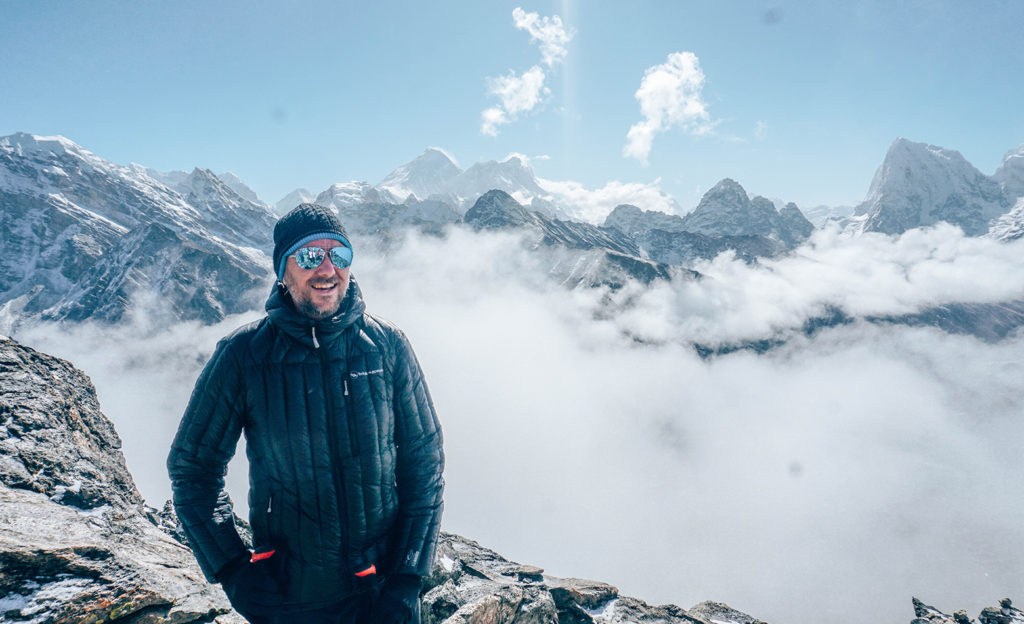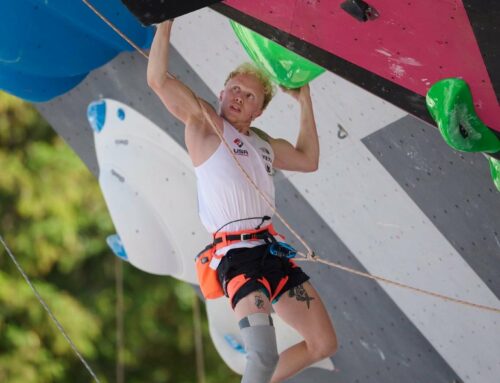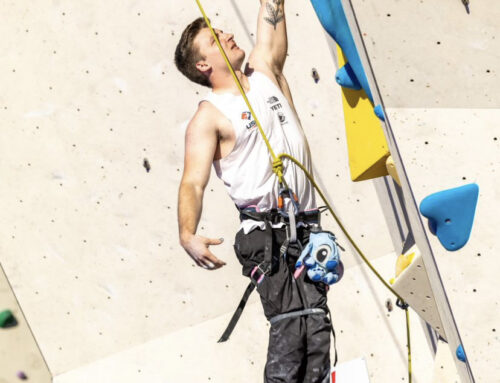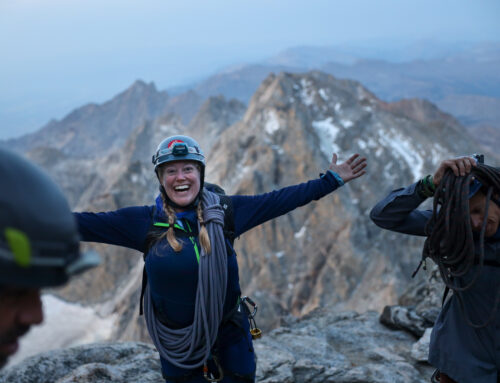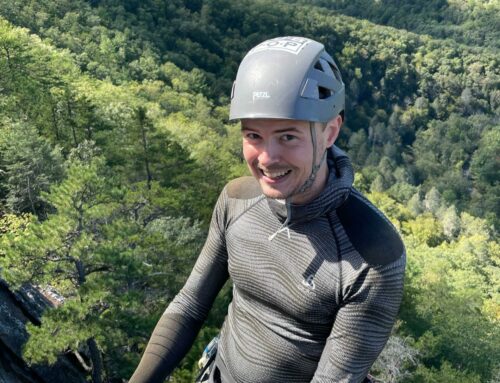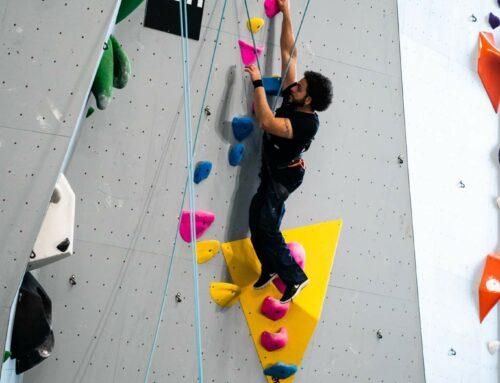Meet Trevor: Paradox Participant, Artist and Musician
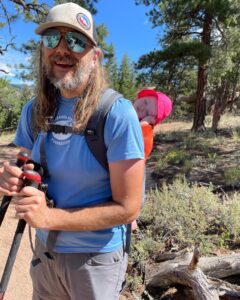 Tell us about yourself.
Tell us about yourself.
I’m Trevor. I was born in Colorado so I grew up living in the outdoors and enjoying the outdoors and I’ve been very active in the outdoors- everything from camping to mountain biking to climbing to river sports, I’ve done everything. I grew up here and I would escape to the outdoors because I have been going blind my entire life and I would usually escape to the outdoors after being teased or bullied at school and that kind of brought me to art as well- because I am an artist as well- and that would keep me happy. Creating art and getting into the outdoors. So that is a little bit about my background as far as what I would do as a young child.
My eyes started deteriorating really fast in 2014 and so all of that kind of disappeared- art, climbing, sports, everything disappeared because of it. So I started spiraling into a deep depression at that point. I didn’t know where to turn for happiness or anything. I basically started figuring out stuff, it was almost the end for me but then I decided one day that this wasn’t going to be it so I started doing a little climbing here and there with different groups and on my first climb after losing total site, except for light- now I can only see light, I climbed for the first time and I was going up I started feeling different things on the rock and I had this vision that basically rocks are sculptures. So I started feeling all of the edges and realized that climbing is art, I started thinking of sculptures and I got to the top and gained a lot of confidence as far as climbing. I realized I can still do these things just by feel and touch.
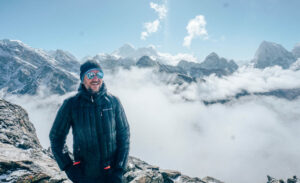 I call myself ‘Art Through Touch’ which is my art and climbing personality. I did that and then realized that I wanted to do something bigger so I signed up for this trip that was going on to go over to Nepal. I had no idea what I was getting myself into- I was getting out of my comfort zone. I signed up and fundraised. I was really interested in helping kids with disabilities at that point because I didn’t want people to go through those things. We went over and helped at an orphanage for disabled children. There was also a trip to climb a mountain over there afterwards. I climbed a mountain called Gokyo Ri, it was 17,575 feet. I had never done anything that big before. I had climbed some 14ers when I could still see. I was scared to death. I just said, “Ok, this is it!” I met a guy from Chicago and I believe in collaboration of strengths, so this guy was on the trip and is a Veteran and suffers from PTSD and a traumatic brain injury. He was my primary guide. I don’t need tons of guidance but the trail was pretty treacherous, there were 1,000 foot drops and I had to be very cautious. He would guide me and we became really good buddies. During the trip, he said “You know, dude, this is really cool because you’re giving me purpose.” In the military he had a mission and a responsibility. I was kind of like his mission and responsibility. So we basically gave each other a purpose- we were collaborating on our strengths. I would give him motivation and he would guide me. That’s what I love to do back here, help people with their goals, barriers and at the same time they can help me. Someone who may not walk or someone that may have trouble carrying weight, I can do that, and they can be my eyes so we can team up and work together. I coined the phrase ‘Collabability’. So if you collaborate, you are basically a totally able body.
I call myself ‘Art Through Touch’ which is my art and climbing personality. I did that and then realized that I wanted to do something bigger so I signed up for this trip that was going on to go over to Nepal. I had no idea what I was getting myself into- I was getting out of my comfort zone. I signed up and fundraised. I was really interested in helping kids with disabilities at that point because I didn’t want people to go through those things. We went over and helped at an orphanage for disabled children. There was also a trip to climb a mountain over there afterwards. I climbed a mountain called Gokyo Ri, it was 17,575 feet. I had never done anything that big before. I had climbed some 14ers when I could still see. I was scared to death. I just said, “Ok, this is it!” I met a guy from Chicago and I believe in collaboration of strengths, so this guy was on the trip and is a Veteran and suffers from PTSD and a traumatic brain injury. He was my primary guide. I don’t need tons of guidance but the trail was pretty treacherous, there were 1,000 foot drops and I had to be very cautious. He would guide me and we became really good buddies. During the trip, he said “You know, dude, this is really cool because you’re giving me purpose.” In the military he had a mission and a responsibility. I was kind of like his mission and responsibility. So we basically gave each other a purpose- we were collaborating on our strengths. I would give him motivation and he would guide me. That’s what I love to do back here, help people with their goals, barriers and at the same time they can help me. Someone who may not walk or someone that may have trouble carrying weight, I can do that, and they can be my eyes so we can team up and work together. I coined the phrase ‘Collabability’. So if you collaborate, you are basically a totally able body.
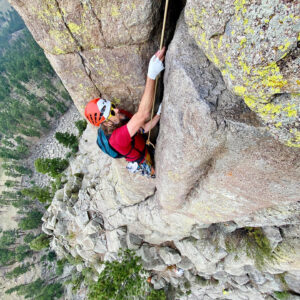 What got you into climbing?
What got you into climbing?
Before I lost my sight, youth groups got me into climbing. There wasn’t any of the major indoor rock climbing, I started climbing before indoor rock gyms were really a thing. The first time, I think I went with a youth group in Fort Collins, like a summer camp kind of thing. I loved it, we went up to a place that’s now called Rotary Park by Horsetooth Reservoir. I remember loving it. Then I would do a little bit here and there with friends, that’s why I loved climbing, going out and hanging out with friends and cheering each other on and chatting.
What got me back into climbing after losing my sight was that I was thinking about sports that I could maybe excel at and be more independent at. I wanted a more independent sport. You know, there’s mountain biking, I used to mountain bike but someone’s steering for you. I do snowboard still but someone is basically always telling you when to turn, it’s fast paced so you do need someone to do that for you, but climbing seemed really independent to me. Where I could feel different holds and feel everything at a slower pace rather than relying so much on a partner. You still need to depend on your partner, but not as much as other sports. They might be calling out holds, but it’s not the same. That’s why I love crack climbing. Crack climbing gives me the most independence of anything because there is always a crack to follow. The crack gave me the opportunity to use it in an artistic way. Anything in the crack was a hold basically, it’s not like you are on a big granite face and having to scan the rock, you can just jam a foot wherever in the crack. It gave me a lot more independence on a line. Other types of climbing I have to rely on my partner a lot more to tell me “go to the right, go to the left”, the crack you just follow all the way to the top.
Climbing gave me a way to feel the different knots and carabiners. Climbing called to me as far as independence and it feels relaxing and empowering to me. At one point I would love to start lead climbing. Leading a sport climb with bolts is extremely hard because you have to rely so much on your partner, but leading a crack climb, it’s possible to do that without sight. So that’s my goal to do that eventually. To be able to be the first one up and contribute to the team, I mean you contribute by following and cleaning gear as well, but it would be cool to do that at some point.
What are some of your goals and/or objectives for climbing?
Oh yeah, there are several! Leading is foremost, leading my first trad climb. I’m also planning on climbing the Diamond on Longs Peak. Longs Peak was also something I could see from my house in Fort Collins. So when I could see, I would see it and think “I’m going to climb that soon” but I never got around to it. Even hiking the standard route. Then I lost my sight and was like “Aw man!” Actually, hiking and scrambling is harder for me than vertical climbing. So the first time I want to do it is to climb the casual route on the Diamond. Start out with that, make it a two or three day thing and camp up there because it takes me a while to hike in. I’m also not an alpinist by any means and that’s an alpine climb.
I also want to do another tower in Utah. I really got into climbing towers because they give me something more than a single pitch climb does. The exposure and being way up there. Last September I climbed Devils Tower in Wyoming which was my first ever multi-pitch climb. I was also learning trad climbing up there as well. So that was my first multi-pitch but I want to get a tower out in Moab this fall when it cools down again. Maybe Castleton Tower or something like that. Towers have been calling to me because of the exposure and you get something else from it. When you can’t see, you can maybe hear a river way down there and you can kind of get the feeling of the height.
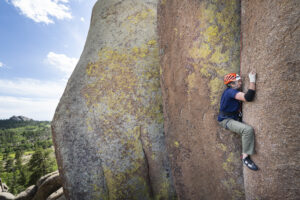 I have huge goals in other countries too but I want to build up and start in my backyard for now. I have the Grand Tower and the Trango towers on my mind, they’re in Pakistan. It’s about 4,000 vertical feet. I will start with Longs because it’s about 1,400 vertical feet, do some towers, and leading my first trad route are my first goals.
I have huge goals in other countries too but I want to build up and start in my backyard for now. I have the Grand Tower and the Trango towers on my mind, they’re in Pakistan. It’s about 4,000 vertical feet. I will start with Longs because it’s about 1,400 vertical feet, do some towers, and leading my first trad route are my first goals.
Can you tell us a little bit more about the Paradox trips you’ve been on? What was your experience?
So I was climbing and I basically couldn’t find any climbing partners to continue my journey and continue with my climbing goals. So I started looking for other adaptive organizations and Paradox popped up. I had heard of Paradox before but never really done anything big with them. I had recently gotten into ice climbing because I wanted to do something in the winter that was climbing related as well. So I signed up for the Ouray trip. I didn’t know what to expect but decided I would go even though I didn’t know anyone. I got a carpool from here and the first time I met one of the participants he was very welcoming and we connected immediately. We started talking about climbing and goals and our stories. So we got down to the event and everyone there was the same way. They didn’t get scared away by my white cane but wanted to engage and hear about my story. Everyone was so welcoming to begin with. It gave me so much happiness that my cane disappeared, it was just people that were stoked about climbing together. I was handed ice axes and given an opportunity, I was looked at as a person that can do things. It was more of “We’re here to support you, but go up and crush it. Here’s a little bit of technique” Then there was someone right there next to me from Paradox giving me guidance rather than treating me like someone that doesn’t know anything. Everyone was cheering each other on, giving each other high fives when possible. It was so incredible to have a community like that. I had lost that a lot when a lot of climbing partners that I used to have would stop responding but now when I found Paradox, everyone was there for each other. No one cared if you climbed 10 feet off the ground or made it all the way to the top. It was about empowering each other and elevating each other to believe in yourself and help believe that you can do things. All of the volunteers also treated everyone as climbing friends and wanted to know more about your life and story rather than just instructing you on how to do things or being there to belay. It brought me back to the time of sitting down at the base with friends, not even climbing, just chatting away. There are so many sculptures and cool things to see ice climbing with just hands. So I would take my hand off of the ice axe every once in a while and feel the formations with my glove. It’s really cool because it’s all sculptures and there are a lot of sea shell shapes.
I considered the canyon our “Fortress of Solidarity”. Superman has a Fortress of Solitude and so we had the Fortress of Solidarity between Paradox climbers.
Shelf was pretty much the same way. I had more experience in rock climbing than ice climbing so I didn’t need a lot of assistance there. But what I noticed at Shelf was that Paradox lets you learn and do other things rather than just the act of climbing. There’s more to climbing than just climbing; it’s belaying, it’s being a part of a team, it’s cleaning a route, it’s learning knots, you know, there’s a lot of things to climbing that aren’t actually climbing. I felt really safe, comfortable and happy because I was able to do other things like belay and tie my own knot. It was so cool to do everything as if we were a team of climbers rather than an organization doing a clinic or something like that. At the same time, everyone learned and was safe, but it was really cool to be taught where to go if Paradox isn’t there, if you are just climbing with someone in the community. And hopefully, a lot of people in the community will see that you can be safe too, even if you have a barrier or an obstacle. You can do everything the same way and safely. Both of these trips prepared you for moving out on your own, independently and with other climbing partners.
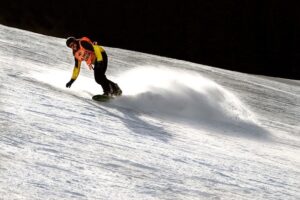 Are you involved with any other adaptive organizations?
Are you involved with any other adaptive organizations?
I go snowboarding with an organization called Stars. They’re in Steamboat Springs and they’re who I usually go snowboarding with. They do a lot of other things like mountain biking and horseback riding as well but I am really pleased with their winter programs. The organization that got me back into climbing was No Barriers USA. They are more Veteran and youth based. It’s more like once a year type stuff. My very first climb was with them after losing my sight. I will sometimes help with No Barriers by pushing wheelchairs and doing stuff like that too.
I also do some stuff with the Museum of Art in Fort Collins. I help them out with a mask exhibit that they do every year to fundraise by creating a mask for them. That was the first piece of art that I created after moving back into life. I created a sculpture out of this mask, they provided the forms for the mask and then they auction them off every year. I’ve done it for five years now. The first one I created was called “Igniting from the Darkness” so that was kind of like the first thing that I did to come back into where I wanted my life to go.
I tried starting my own thing called “Hiking with Sight” with another person. We were climbing a mountain with her on my back. She has spina bifida and I couldn’t see so I carried her and she was my eyes. So we had to collaborate.
I feel that Paradox is more of a community for me because it encompasses everyone. I really love hanging out with Veterans and everyone. It gives a lot of opportunities to everyone in all walks of life.
When/how did you learn how to play the harmonica?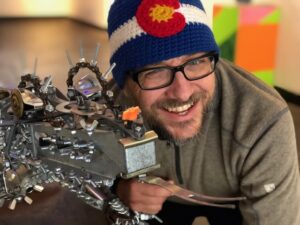
I started playing the harmonica after losing my sight. I was trying to figure out creative avenues that I could get into. I had a lot of anxiety so I was trying to find things that would calm that. Music popped up and I love music. I used to play percussion in Junior High and High School. I started thinking of some instruments that could travel with me. The ukulele popped up, I got a ukulele and started strumming on it and realized that I would need a teacher for it. I kind of gave up on that. Then I moved onto the harmonica and that’s just notes in different holes rather than having to push a bunch of strings at the same time and strum. So I started blowing into a harmonica and listening to the notes and through trial and error I figured out how to make notes. I started with kids songs like ‘Twinkle Twinkle Little Star’ because they’re really easy and you don’t need a lot of bending. You can bend notes to get more notes because there are only so many notes on a harmonica, but ‘Twinkle Twinkle Little Star’ didn’t require that. Then it developed from there and I was learning other songs that I liked. I did some YouTube browsing to learn more. ‘Somewhere Over the Rainbow’ is one of my favorites. I played it for my wife at our wedding reception. I also like to play ‘It’s a Wonderful World’. I really like playing positive songs. I also got into theme songs to pump people up, Rocky Theme is what I like to play when people are climbing. I remember I played the Star Wars theme song in Ouray.
Is there anything else you would like to share?
Hopefully people will include those that might have an obstacle into their adventures. It definitely adds to the fun and they likely have something to add to the overall experience.
Photo Descriptions:
Photo 1: Trevor smiling at the camera while out on a hike. It is blue skies and sunny. He is carrying his daughter on his back as she sleeps.
Photo 2: Trevor standing in front of a large, snowy mountain landscape in Nepal. He is smiling at the camera and wearing a puffy jacket, beanie, and sunglasses.
Photo 3: A climbing photo of Trevor taken from above. He is crack climbing and high above the trees below. He is mid-move, placing his right hand into the crack.
Photo 4: Another crack climbing photo. This is a side view image of Trevor in a crack on a big rock face. In the background, there are green pine trees and another rock formation off in the distance.
Photo 5: Trevor snowboarding. He is making a turn and spraying snow behind him. He is wearing an orange vest and a bright yellow jacket.
Photo 6: Trevor is smiling with a sculpture that he built. It is made out of metal. Trevor is wearing a knitted beanie with the Colorado flag as the design.


